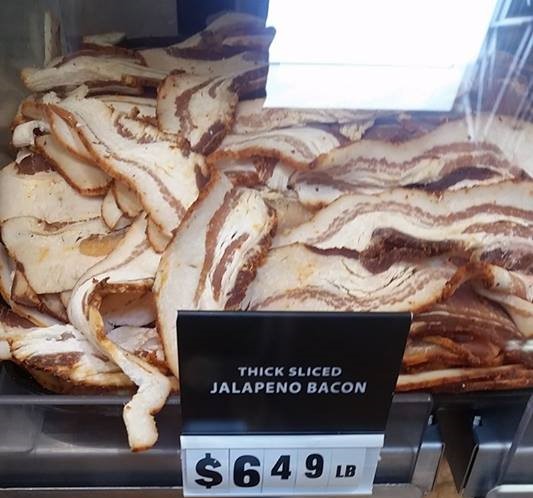In order to obtain a trademark registration, you have to show your mark actually being used on the goods or services being claimed in the application. It’s called providing a specimen of use. Sometimes, that is really easy. Nike claims their “Swoosh” on shoes, and there it is on the side of the shoe (and the tongue and likely the back, too). It is also on the box in which the shoes are housed, and on the bag that holds the box on the way out of the store. It’s kind of hard not to connect the Swoosh to the shoe.
But what if you aren’t Nike? Do you have to find where to print labels, boxes, tags, bags, and maybe tattoo some people? No, but you do have to make it easy for people coming into contact with your goods to also come into contact with your mark. Let’s pretend instead of selling shoes, you are selling bacon. You probably don’t want to emblazon your mark directly on the bacon. (If you do, no judgment here, but don’t be surprised if you aren’t at everyone’s breakfast table.) Instead, you can put it on the plastic wrap around the bacon or on a hangtag connected to it. A customer can’t pick up the chunk ‘o smoked pig without seeing your mark.
Let’s contrast that to just putting that logo on your website or social media pages. Because eat-o-vision hasn’t been invented yet, people likely can’t access your bacon directly from your Instagram posts. If you try supporting your application with just some Instagram posts of your bacon sizzling in the pan and creatively arranged on a plate, the USPTO will likely determine that those photos don’t show the mark being used on the claimed bacon goods. Rather, they are just advertisements for the bacon. We have to show actual use on or near the product (like a point of sale display) rather than advertisement separated from the product itself.
If the photo was on your website, with the bacon and your mark with a good old “Buy Here” button that takes actual orders – not just a map to where I have to drive out in the cold, wet rain to pick up your bacon. Then you have that connection again. My thought as a consumer goes, “Oh, I know that brand. They make my breakfast greasier but better with their awesome bacon. Yay, I can get it right now!” Ta-da! Specimen of use level complete.
However, if I have to say, “Oh, I know that brand. They make my breakfast greasier but better with their awesome bacon. I better write that down so I remember to pick it up later. Now where did I put that pen? And my phone? Maybe I’ll just eat eggs.” Boo. Specimen of use fail.
Let’s recap. If I have an ability to fulfill my need to purchase bacon immediately upon seeing your mark (even if it isn’t instantly delivered) = Good specimen of use! If I have to rely on memory when I am faced with many choices of slabs of cured pork to remember yours = Bad specimen of use. Now let’s go get some breakfast!


